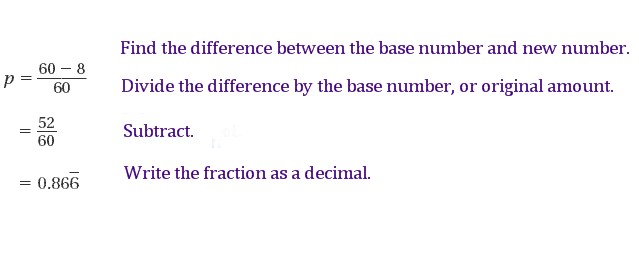Percent Change
The "percent change," or "percent of change" shows how much a quantity has increased or decreased in relation to the original amount. When the new amount is greater than the original amount, the percent change is called a percent of increase, or just "percent increase." When the new amount is less than the original amount, it is called a percent of decrease, or "percent decrease."
Percent Change
Use the following equation to find the percent change:

Percent Decrease
Example
During the summer, a bear's heart rate is about 60 beats per minute, but it can drop to as low as 8 beats per minute during winter. By what percent can a bear's heart rate decrease during the winter?
Solution
To find the percent decrease in a bear's heart rate, use the percent change equation.

The percent decrease is about 86.7%.
Decimal Method
Example
What is 15% of 60?
Solution
Step 1 Write the percentage as a decimal.
15% = 0.15
Step 2 Find the product of the decimal and the number.
0.15 (60) = 9
Percent Increase
Example
From October to November one year, there was a 27.4% increase in attendance at Everglades National Park. If there were 59,084 visitors in October, about how many people visited in November?
Solution
Step 1 Find the increase.
Step 2 Add the increase to the original amount.
New Amount = 59,084 + 16,189
= 75,273
About 75,273 people visited the park in November.
